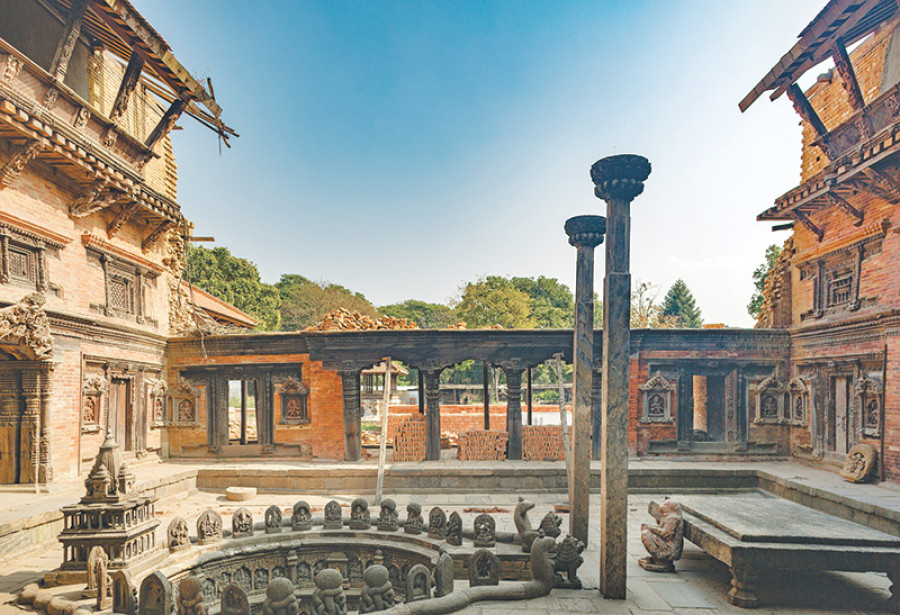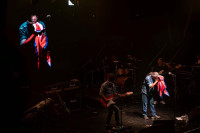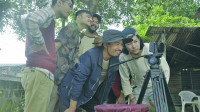Entertainment
Restoring the most beautiful courtyard in Nepal
It is almost three years now that the devastating earthquakes hit Nepal, ravaging and terrifying the people and the landscape. Rebuilding has been slow, the government lagging,
Sophia L Pandé
It is almost three years now that the devastating earthquakes hit Nepal, ravaging and terrifying the people and the landscape. Rebuilding has been slow, the government lagging, the head of the National Reconstruction Authority (NRA) has changed multiple times due to political wrangling, and most people seem apathetic of the government’s will to really help its people.
Amid this morass, it is worth mentioning that the Patan Durbar Square and its adjoining palace complex is busily being repaired with dozens of people at work every day on 12 ongoing restoration projects—repairing and rebuilding the monuments and artefacts damaged by the earthquakes.
The multi-crore-rupee Patan Durbar Earthquake Response Campaign (2015-2021) launched just a day after the quake by the Kathmandu Valley Preservation Trust (KVPT) aims to restore the entire square and the Patan Palace by the year 2021, contingent on available funding. Today, walking across the square, instead of rubble, there is labelled scaffolding, describing the institutions or individuals who have generously given to the 26-year-old Trust.
While the furore over who should rebuild the iconic and beloved Kasthamandap (our Valley’s namesake situated in a still devastated Kathmandu Durbar Square) continues, the KVPT quietly rebuilds: One of its first major accomplishments was to repair and restore the fallen and squashed copper repoussé statue of King Yognarendra Malla to its place on the pillar looking east towards the three-storey Degutale temple.
While work continues around the square and the palace complex, the KVPT’s ten-year-long restoration of the Sundari Chowk (2006-2016), long considered the most beautiful courtyard in the Valley and an example of the grace and ambition of Newar Architecture at its best, is now complete and open to Nepali nationals for an entrance fee of Rs 30 which covers a visit to the Patan Museum’s Keshab Narayan Chowk, the Mul Chowk (or main courtyard), and the now complete inner-most Sundari Chowk, accessed via the Mul Chowk or circuitously through the gardens that are home to the also restored Bhandarkhal tank and its intricate stone pavilion.
The travails of fund-raising and gathering expertise for the restoration of this storied courtyard are recorded in a beautiful, scholarly book published by the KVPT as documentation for future restoration efforts—but for those who are not necessarily engrossed in the essentials of architectural history and are just enamoured by magnificent edifices, an unparalled use of space and light, a window into an exemplary of Newar architecture, the artistic traditions encapsulated within it, and a unique, innovative example of converting a palace into a museum, the beautiful courtyard is waiting to be visited.
The adaptive re-use of the 17th Century (thought to have been first built in 1627 CE) southern most addition to the Patan Durbar made by King Siddhinarsingh Malla, now includes within its restored walls an architecture gallery that houses a permanent exhibition illuminating the tradition of Newar Architecture. For those who may want to see how the Sundari Chowk itself may have been conceived and constructed, along with galleries with mud-floors and exposed wall paintings have been left untouched by the restorers so that the public may experience the feeling of bare feet on finely laid mud, an aspect that has now been taken over by brick tiling in an emulation of tradition that is not strictly accurate but more practical: The mud floors in the Sundari Chowk must only be stepped on without shoes and the galleries are closed weekly for maintenance in order to keep these fragile floors intact.
Today the Sundari Chowk is an emblem of a decades-long dream to establish architectural galleries within it—celebrating the arts that house them. The permanent collection in the grey painted Architecture Gallery, curated by Niels Gutschow, holds works of drawings and carefully recreated architectural edifices that seek to elaborate how former generations set about creating components of palace spaces such as the Sundari Chowk. As the Patan Museum, a former part of the palace restored by Götz Hagmüller, contains modern elements re-imagined to further enhance a contemporarily curated collection, so does this newly opened architectural gallery create fresh opportunities for larger pieces that can hang in spaces that would never have been used otherwise.
The North, South, and West Wings of the Sundari Chowk had been completed by the time the earthquake struck in April, 2015; they remained intact due to the structural fortification during the restoration (construction began in 2009, the former two years were devoted to fund-raising), holding despite the violent tremors. The as-yet unrestored East Wing collapsed, and it is this wing that was reconstructed with loving detail in keeping with the fortuitous documentation that had preceded its collapse. The East Wing now houses the double storey Architectural Gallery that is an example of adaptive re-use, creating a venue hitherto unseen before, similar in intention to the glass pyramid juxtaposed in front of the former palace that houses the collection of the Louvre; a choice now widely admired even while its detractors would have had it removed.
The Sundari Chowk is now available for big, ambitious exhibitions that the previously dark palace interiors could not have housed, in keeping with its analogue in the galleries of the Patan Museum which hold an open-air staircase that is bracketed by the glorious struts of the Bhai Degah Temple that may never have been seen at eye level in an older, lower ceilinged gallery structure. The restoration of the Sundari Chowk has accounted for and followed in the tradition that allowed its own organic adaptive evolution from palace complex, destroyed multiple times over the past four centuries, to the prison and Malpot office that it once housed before its restoration as an annex to the Patan Museum.
If you have missed this painstaking, thoughtful, exquisitely documented restoration, that followed the stringent rules of the government run Department of Archaeology, it is now time to go and see it for an experience of what can be accomplished given the will, the vision, the discipline, and of course the funding.




 12.12°C Kathmandu
12.12°C Kathmandu










